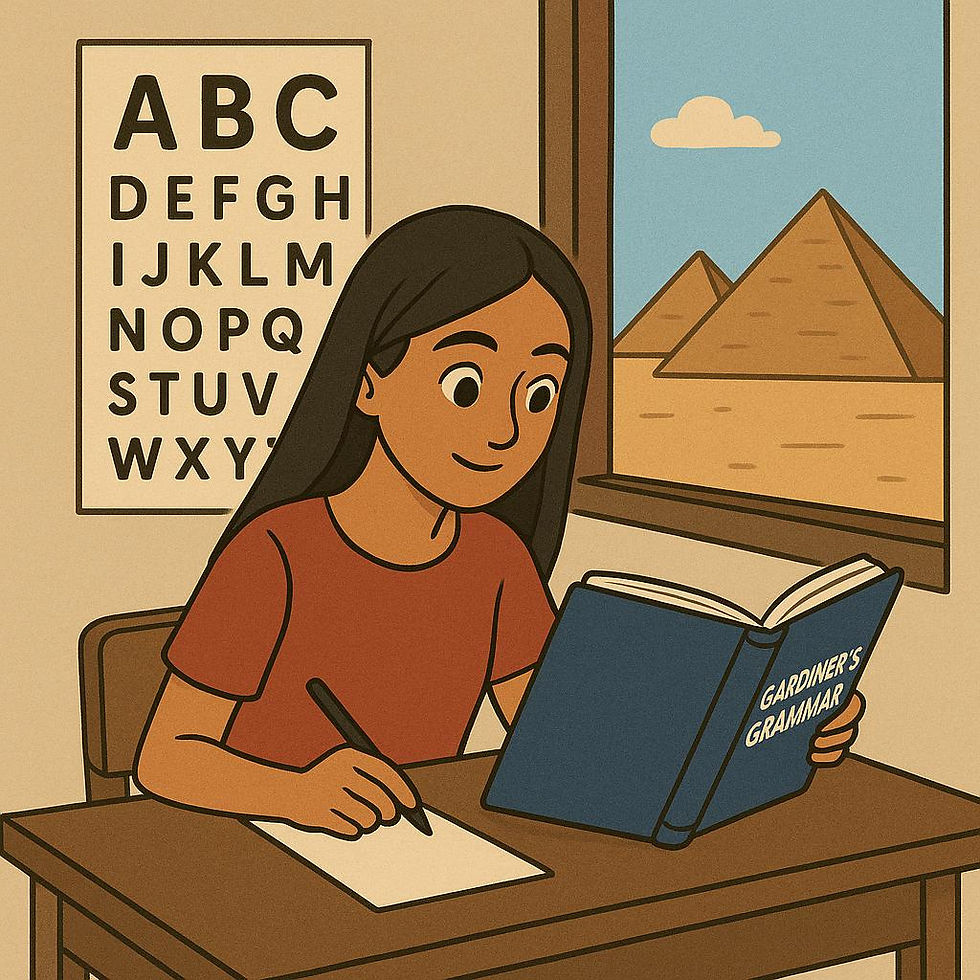Ten-minute hieroglyphs - Lesson 2: Transliteration and starting to learn the 'alphabet'
- Dr Sian Thomas

- Jun 20
- 3 min read
Updated: Jul 5

Learning objectives
By the end of this lesson:
you will be able to explain in simple terms the purpose and importance of 'transliteration'; and
you will have met some phonetic hieroglyphic signs
You will learn 13 hieroglyphs as follow-up work.
Hieroglyphic writing and transliteration
You learned in the last lesson that hieroglyphs can represent sounds or ideas. In Middle Egyptian, words are often written by spelling out the consonants in the word using phonetic hieroglyphs (the vowels are omitted), then adding one or more 'determinative' hieroglyphs that give the reader an idea of the general meaning of the word. For example, consider the following word, which means 'ship':

The hand sign represents the consonant 'd'. The rectangular sign represents 'p', and the one with the curved top represents 't'. The picture of the boat at the end of the word is a determinative that indicates that the meaning of the word is connected with the idea of boats - you'll also find it at the end of some other words for boats and verbs that have to do with sailing.
Translation of hieroglyphs is done in two stages:
Transliterate. Transliteration means writing down the consonant sounds of words. The transliteration of the above word is dpt (I'll explain later how we know the order in which to transliterate the signs). The 'boat/ sailing' determinative is not transliterated because it is not being used as a sound sign. Note that when typing transliterations it is conventional to use italics: this makes transliterations easy to spot.
Many of the letters used in transliteration - like d, p, and t - are standard letters that we use when we write English. All of the signs that you will learn following this lesson have such transliterations. In addition to these, transliteration uses some 'extra' letters created by adding diacritics (like dots and dashes) to ordinary letters, as well as a couple of less familiar signs. We'll meet these in Lesson 3.
This is a very simplified explanation of transliteration. Before moving on to Lesson 3 you should deepen your understanding by reading the post What is 'transliteration' and why is it an essential step in translating hieroglyphs?
Translate. We now put together the information provided by the transliteration and the determinative to arrive at the translation 'ship'.
The hieroglyphic 'alphabet': one-letter (AKA 'uniliteral') signs
We now need to start learning the phonetic hieroglyphs. There are rather a lot of these, as Egyptian had hieroglyphs representing single consonants as well as hieroglyphs for certain combinations of two and three consonants. It's best to learn the signs gradually, and to start with the one-letter signs.
All hieroglyphs are pictures, but when learning phonetic signs focus on memorising the transliteration, not what they're pictures of. For example, the hieroglyphs above are actually pictures of a hand, a stool and a loaf of bread respectively, but in the word dpt they stand for the sounds 'd', 'p' and 't', not anything to do with hands, stools or bread.
As follow-up work for this lesson, you will learn how to transliterate 13 one-letter ('uniliteral') signs. These include the three signs (d, p, and t) that you met above. The link below will take you to a set of flashcards that you can use to help you memorise the signs and a quiz you can use for practice. The flashcards have the hieroglyph on the front and its transliteration (in italics) on the back.
When you're learning these hieroglyphs, you'll probably want to read them out loud. For the 13 hieroglyphs introduced here, it's easiest just to use the closest equivalent English consonant. You should note that this pronunciation is for academic convenience and is NOT an attempt to say the word like an ancient Egyptian. Reconstruction of true pronunciation is difficult and, in the absence of a Tardis, not really possible.
Follow-up
Read What is 'transliteration' and why is it an essential step in translating hieroglyphs?
Use the Lesson 2 activities to learn and quiz yourself on your first 13 one-letter signs.



